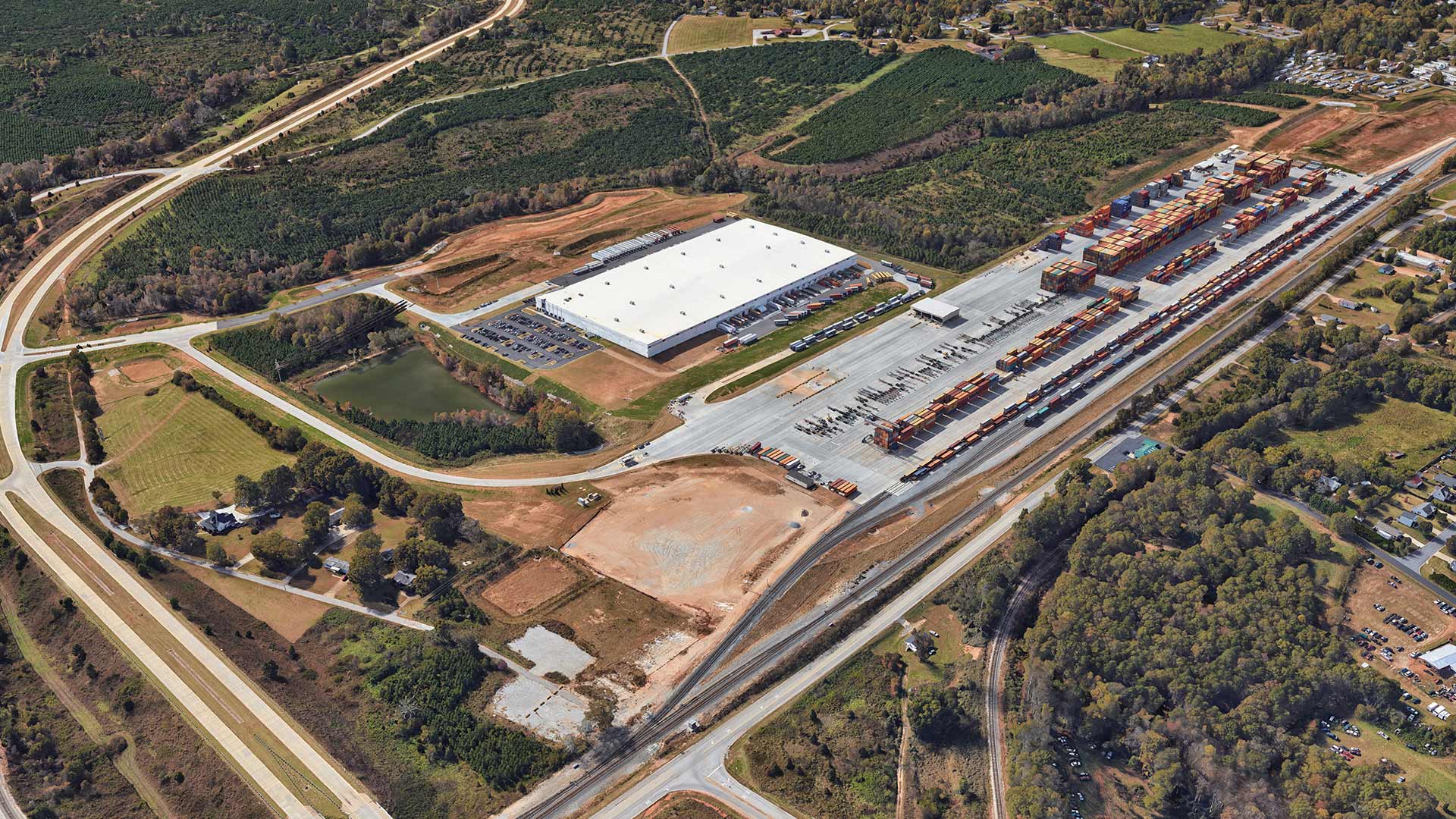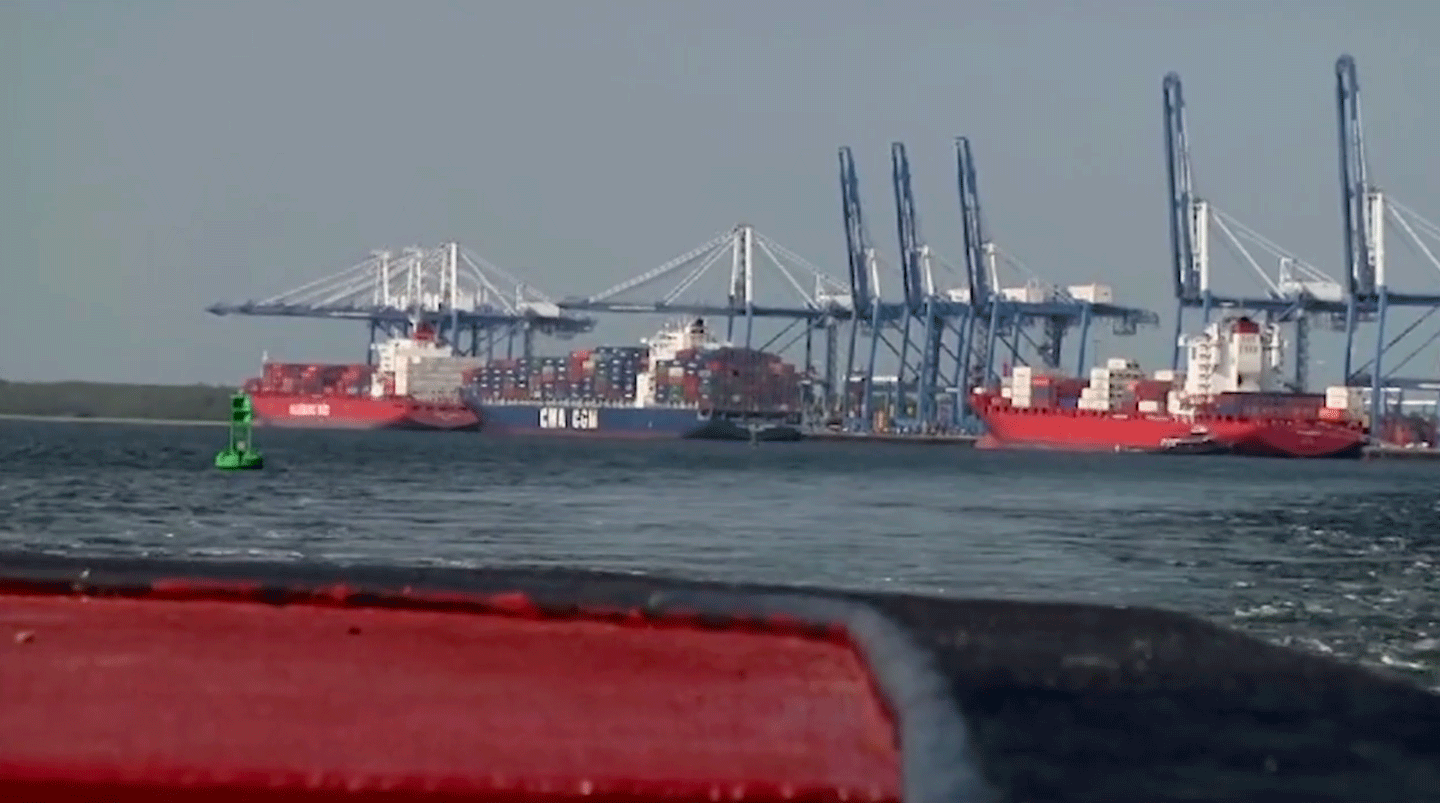Addressing South Carolina’s Supply Chain Desert
Prior to CenterPoint’s involvement in the SCIP, major manufacturing and distribution companies relied solely on the Ports of Charleston and Savannah to import and export commodities to the Upstate and surrounding southeastern populations. Thousands of trucks trafficked the local commuter interstates, magnifying highway and port congestion issues, which drove the decision to develop the SCIP.
The goal of this inland port project was to not only alleviate traffic congestion, but also create employment opportunities and increase supply chain efficiencies for the Upstate region. With a large-scale supply chain hub in the western part of South Carolina, large Beneficial Cargo Owners would be able to reap the economic advantages of rail versus truck shipping, and minimize their carbon footprints.
An Inland Port Grows in Greer
CenterPoint chose to invest in the Upstate due to its proximity to dense populations, maritime ports, Class-I railroads, airports and interstates. The Upstate is situated between two of the largest cities in the southeast, Charlotte and Atlanta, and is one of the most rapidly growing areas of the country and the fastest in the state.1
Greer, a central city in the Upstate, is located in the northwestern corner of South Carolina along I-85, one of the busiest interstates in the nation. Regarded as one of the most efficient and cost-effective locations for warehousing and logistics services in the southeast – with immediacy to Interstates-85, 77, 26, 185 and 385 – Greer was a model location to develop the SCIP.
The SCIP, developed in partnership with the South Carolina Port Authority, is 212 miles from the Port of Charleston and 235 miles from the Port of Savannah. Charlotte is 92 miles away, Atlanta is 155 miles away, and the GSP International Airport is minutes from the inland port. The SCIP’s central location and access to ocean ports of entry, major cities and highways make it an ideal location for both warehousing and distribution centers. Norfolk Southern Railway, which has exclusive rights to serve the inland port, expects to move about 40,000 containers through the facility each year, with the potential to accommodate 100,000 lifts annually within five years.
According to the South Carolina Inland Port Summit held in October 2013, the SCIP is designed to achieve several goals and provide a cheaper alternative for companies importing and exporting containers. The 212-mile rail line from the Port of Charleston to the SCIP terminal in Greer allows Norfolk Southern to ship thousands of containers to the terminal, where trucks pick them up for transport inland.2 By providing a storage facility for empty containers, the inland port significantly reduces local truck traffic. Norfolk Southern is committed to moving the needed containers overnight in order to keep freight flowing through the Atlanta and Charlotte areas, which both have substantial rail resources.3
BMW and Beyond: Real Estate Development at the SCIP
The first distribution center developed at the inland port opened in October 2013 for BMW Manufacturing Company. The 414,534 square foot built-to-suit distribution facility is under a long-term lease agreement with CenterPoint. The property is situated on 31.14 acres, which the land is under a long-term lease from the Greenville Spartanburg Airport District.
With close proximity to their existing 4.5 million square foot manufacturing facility and direct rail access via Norfolk Southern, the location gives BMW complete control of their inventory, The distribution facility’s intermodal adjacency also allows BMW to reduce its demurrage and realize considerable drayage savings. By relying on Norfolk Southern to ship BMW parts from Greer to the Port of Charleston, an estimated 25,000 trucks will be removed from I-26 annually—significantly reducing fuel and emissions, and mitigating highway congestion.4
The built-to-suit facility features a 10,000 square foot main office with a 1,000 square foot warehouse office space, 30 trailer and 215 auto stalls, 80’ speed bays, is 32’ clear and cross-docked with 40 dock doors and 2 drive-in doors. This property serves as BMW’s warehousing and logistics operations center, preparing parts and components for export to markets including Russia, Thailand, India, Indonesia, Malaysia and Egypt. The facility is expandable by nearly 300,000 square feet, offering BMW flexibility as they grow their U.S. manufacturing presence. In order to accommodate the growth of the Upstate, CenterPoint realized the potential in the development and was able to increase capacity at the port, offering a wider range of capabilities at the SCIP.
The Upstate’s superior infrastructure and business-friendly climate have driven significant capital investment in South Carolina over the last several years. According to the Port of Charleston, sixty percent of in-state port business either originates from, or is destined to the Upstate. The inland port provides shippers with an efficient and cost-effective alternative to move products across the state, making the Upstate an appealing location for investment, economic development and job creation.
Capitalizing on South Carolina’s Future State
The Upstate provides the business-friendly, economic environment that CenterPoint thrives upon to produce and invest in modern, Class A facilities. It’s ideal location with access to several interstates, airports and one of the deepest East Coasts ports enables superior supply chain connectivity in every direction.
Over the next several years, this region will likely shift from a manufacturing-heavy area to a balanced industrial market with an increasing distribution presence. Manufacturing will continue to be the region’s selling point, while distribution grows as a result of the inland port and the market’s strategic positioning along the I-85 corridor.
Global demand for U.S. manufactured products is driving industrial real estate throughout the country. This is especially true in the Upstate, where the dominance of manufacturing has led the local industrial market’s recovery to outpace the national markets.5 Going forward, exporters and importers are likely to use the inland port as a staging area for operations up and down the East Coast. Due to the SCIP development, warehouse demand is likely to swell over the next decade, accelerated by the steady arrival of post-Panamax ships at the Port of Charleston. The economic stability of the Upstate, coupled with the local government support, incentivizes continued investment in South Carolina industrial real estate.

